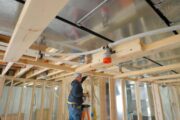(BPT) – When flames engulfed his 1940s beach bungalow without warning, actor Taylor Kinney was thankful to make it out alive. That experience, paired with his role as one of America’s favorite TV firefighters, inspired him to advocate for fire safety and is why he’s partnering with First Alert this fall to share important messages about fire safety preparedness.
“In my role as a firefighter on TV, I help portray very serious and dangerous fire emergency situations,” said Kinney. “But one of the most dangerous of all is the lack of fire safety precautions among a majority of Americans, including having working smoke and carbon monoxide alarms to provide early warning in the event of a real home emergency.”
Recent research shows that more than 60% of consumers do not test their smoke and carbon monoxide (CO) alarms regularly. That, along with other easy-to-perform tasks, can mean the difference between a safe home and a dangerous home.
This simple fire safety checklist can help ensure your home and family are protected from the threats of smoke, fire and carbon monoxide.
1) Install smoke alarms on every level and in every bedroom. Three out of every five home fire deaths result from fires in homes without smoke alarms or with no working smoke alarms, according to the National Fire Protection Association (NFPA). For maximum protection, install smoke alarms inside every bedroom, outside each sleeping area and on every level of the home, including the basement.
2) Testing and maintaining alarms is key. Alarms should be tested regularly and replaced at least every 10 years. Help ensure your alarms remain in good, working order by changing the batteries at least every six months. For hassle-free protection, install alarms like the First Alert 10-Year Smoke and CO Alarm available at Lowe’s, which has a sealed 10-year battery — rendering battery removal and replacement a thing of the past. Many cities and states require sealed 10-year battery alarms, so check with your local fire department if you do not know what to install.
3) Equip your home with fire extinguishers. Beyond alarms, having fire extinguishers — and knowing how to use them — is an important part of maintaining a safe home for you and your family. Every 24 seconds, a fire department responds to a fire, according to the NFPA, so being prepared to fight small fires is critical. Place extinguishers in convenient locations on every level of the home, in the kitchen and in the garage.
4) Protect against the “silent killer.” An odorless and invisible gas, CO is the number one cause of accidental poisoning and can only be detected with an alarm — yet only 47% of homeowners report owning a CO alarm. Consider hassle-free protection by installing 10-year sealed battery alarms and, just like smoke alarms, be sure to check all CO alarms regularly using the “test” button for continued protection.
5) Plan. Practice. Repeat. Recent consumer research reveals that less than 50% of homeowners have an escape plan — and even fewer practice a plan regularly. Make sure to involve everyone in your household in creating a plan and practice it at least twice every year. As part of this plan, equip second-floor bedrooms with escape ladders and discuss how to use them. Identify two ways out of each room and a meeting place outside. Emphasize that once at the predesignated meeting area, call 911 and wait until officials clear your home to re-enter it safely.
For more information, visit www.firstalert.com.


